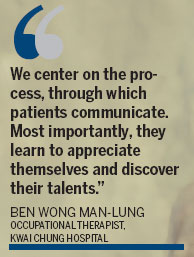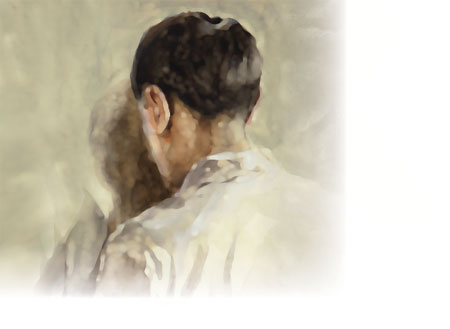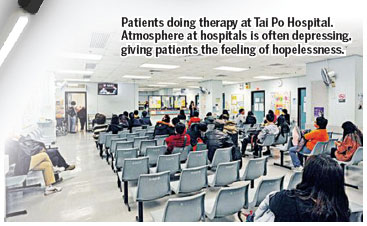Art's healing strokes
Updated: 2013-11-01 07:02
By Ming Yeung(HK Edition)
|
|||||||
When a local artist was hospitalized for treatment of cancer, he felt overcome by the aura of gloom that overhung the place. That gave rise to a fresh vision to lend the afflicted renewed hope, through Art in Hospital. Ming Yeung reports.
Kwai Chung Hospital, one of the city's three psychiatric hospitals, is a dreary, somber-looking establishment. Surely, it doesn't look like a place to inspire vibrant drawings of flowers, animals and afternoon teas. But there they are, modest works of art, adorning the hospital's pale pink walls: a showcase of the works of elderly patients suffering mental illness. The paintings are the achievement of a one-year collaboration between the hospital and the charitable organization, Art in Hospital (AIH).
One of the paintings shows a daffodil, a symbol of good fortune, beloved for its wonderful fragrance. Chinese people put it in their homes, approaching Chinese New year. Tradition holds that a daffodil blooming in the garden on New Year's Day portends good fortune for the entire year.
Attached to the painting is a bird-shaped paper cut in which the characters, "improvement, broad mindedness, joyfulness" have been inscribed by the artist, Lily Chan Lai-lee.
Chan, 73, is one of 18 elderly patients who joined the hospital's pioneer program intended to incorporate art as an adjunct to traditional psychotherapy at the end of 2011.
The painting of the daffodil seems infused with joyfulness and optimism, revealing no hint of the sad history that took away Chan's happiness and assailed her mind for most of her life. "Let bygones be bygones. I focus on my life now, not the past," she stresses. She's changed, she tells China Daily, adding she is no longer "timid" or "small-minded."
"Art therapy provides an alternative to conventional therapy," comments Ben Wong Man-lung, an occupational therapist who specializes in psychogeriatric treatment at Kwai Chung Hospital. "As we emphasize recovery in mental health, we treat patients as service clients. They have the right to choose whatever treatment they see fit."
"We don't analyze the artwork for the patient, nor do we try to interpret what's on the patient's mind through his drawing," he says. "We center on the process, through which patients communicate. Most importantly, they learn to appreciate themselves and discover their talents."
Lily Chan is a "survivor" of the Cultural Revolution, (1966-76). She was born in Malaysia, lived in Singapore until she was 16. Then, in 1956, her mother took her to Xiamen, Fujian, where Lily began high school studies. Four years later, she enrolled in university.
During the years of the Cultural Revolution, Chan suffered mind-blowing experiences. She was condemned as a "spy" and became a target for abuse and discrimination. Chan lowered her gaze where she went, afraid to look other people in the eye, afraid of the condemnation she might evoke if she did.
"I experienced unfair treatment but couldn't speak up," Chan says. She came to Hong Kong after the Cultural Revolution, but the trauma followed her for decades.
As far back as her memories go, Chan remembers being haunted by depression. Insomnia had overtaken her during her high school years, or perhaps, during her university years. "I have always had difficulty sleeping," she said.
Emotional pressure
For years, no one ever read anything into her behavior, or appreciated that there was "something wrong". "After the mental torture on the mainland, the emotional pressure kept piling up after I migrated to Hong Kong in 1980. I had to work in factories to support my three daughters," Chan recalls.
"I don't know why - on several occasions, I wanted to commit suicide - so badly," she recalls. "But my conscience told me I couldn't, because I had to take care of my daughters. Then I would burst into tears and cry out loud. I thought I would feel better after I cried." The situation never improved.
About a decade ago, with encouragement from her daughters, Chan started getting treatment for depression at Kwai Chung Hospital. That was mostly taking pills, until she got in touch through art therapy and started opening up to sharing her thoughts with others.
An artist-instructor would give his geriatric prodigies a theme. Participants would pick their favorite colors and create their impressions of the theme with acrylic paints. They were given an hour and a half to complete their works of art.
Asked which of her drawings she likes the most, Chan picked the one with blossoming yellow and orange sunflowers. "Sunflowers are full of youthful vigor," she explains, admiring her creation. "This is very lifelike. I like the color combination. I think I did quite well."
Susanna Lee, AIH's manager, says the program aims to increase confidence of patients and to restore long-forgotten values, instead of dwelling on unhappy memories.
"Only by living in the present can they face themselves," Lee says. "Patients can open the box of history when they talk to the people who share their experiences. But now all they need to do is enjoy life."
The workshop included painting, making flower banners and taking photos demonstrating that creativity is also therapeutic.
Flipping through her sketch book that she has decorated with cartoon decals, Chan proudly shows off her drawings, her photos and patchworks stored safely inside. She speaks enthusiastically about the dogs her daughter keeps and the yum cha gathering she attends regularly with the alumni of her alma mater.
Kwai Chung Hospital noted impressive results among the patients who participated. Using two psychological assessments, before and after the program, the patients' answers revealed marked improvements in their depressive afflictions.
Art, as an approach to therapy, goes way back. David Edwards, an art therapist in Britain, notes, "Numerous and often conflicting definitions of art therapy have been advanced since the term, and later the profession, emerged in the late 1940s."
Founded in 1994, AIH is a non-profit organization with a stated mission "to serve the community through collective artistic endeavors". Hospitals, in most people's perspective, are dull and dispiriting.
AIH founder Oscar Ho, the former exhibition director at the Hong Kong Arts Centre, recalled how the organization came to be. He had been diagnosed with cancer and underwent chemotherapy at the Prince of Wales Hospital in Sha Tin.
As if being diagnosed with a potentially lethal illness did not already test his inner strengths to their limits, he found the depressing atmosphere, the feelings of hopelessness, were exacerbated by the grey walls that surrounded him in the hospital basement. Ho made a pledge to himself he would do whatever he could to make hospitals less miserable once he recovered.
AIH's first work was a mural created in collaboration with patients of the out-patient clinic of the cancer unit at Prince of Wales Hospital. Since then, AIH has overseen the creation of many murals at different hospitals. There's no fee for the organization's services. It's all done in the spirit of injecting much-needed vitality into an otherwise soul-destroying environment.
Thoughts sharing
After each drawing lesson, participants are encouraged to share their thoughts on what they liked about their own works as well as the works of others.

Another goal of the workshop is to open them up and expand their social networks, Lee adds. She has witnessed the transformation of Lily Chan from being introvert to outgoing.
Art therapy has been increasingly accepted as a supplementary form of treatment by the mental health profession. Hospitals, however, with their budgets already stretched thin, have no money to support art programs.
"I hope the government realizes the benefits of art therapy and thus incorporate this type of treatment in the healthcare expenditure," she suggests. "Or assign designated spaces to conduct these activities."
"Hospitals have seen fruitful results of our projects and, one by one, requested our service at their hospitals," Lee says, but she concedes that some hospitals are impossible to conduct such activities due to their space constraints.
Apart from looking at things from a brighter perspective, Lily Chan says the art workshop ignites her desire to continue learning and revitalize her creativity.
"Most people say the old folks are useless. Through the workshops, however, we know we are like everyone else. Just give us an opportunity, we will do just fine," Chan says.
Then she turns to Susanna Lee and orders, "Open another workshop."
Contact the writer at mingyeung@chinadailyhk.com



(HK Edition 11/01/2013 page4)